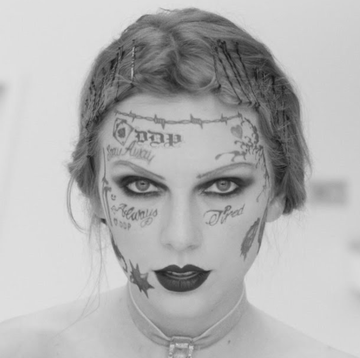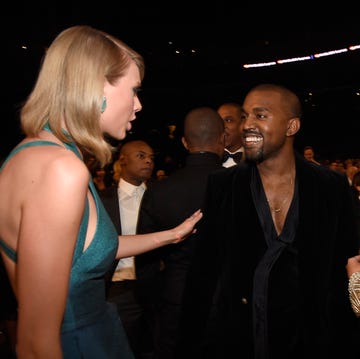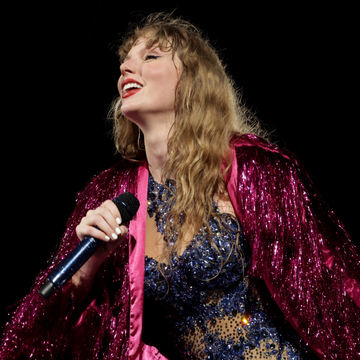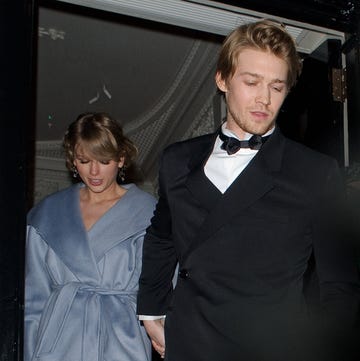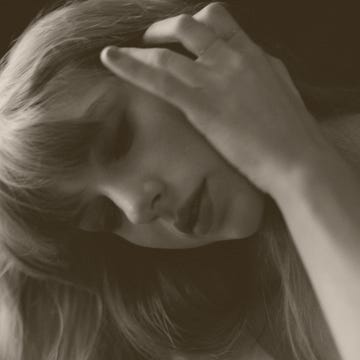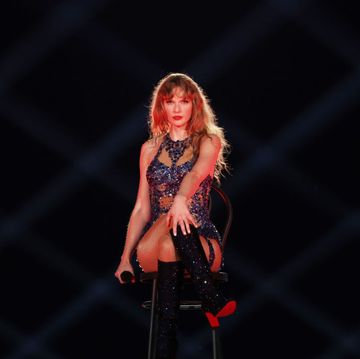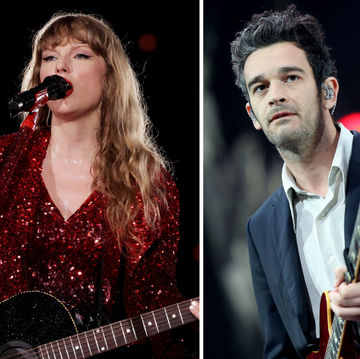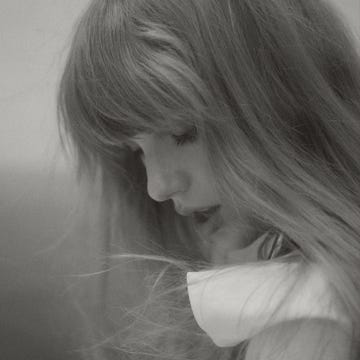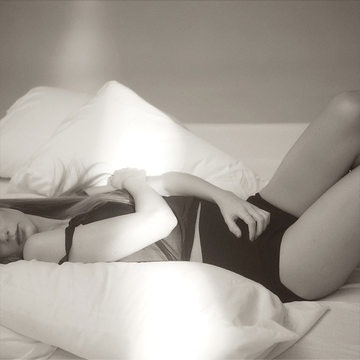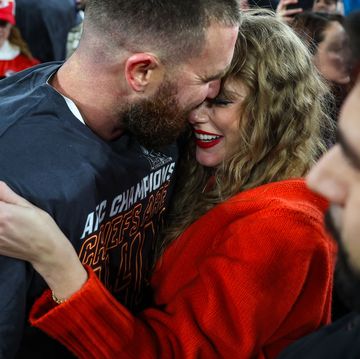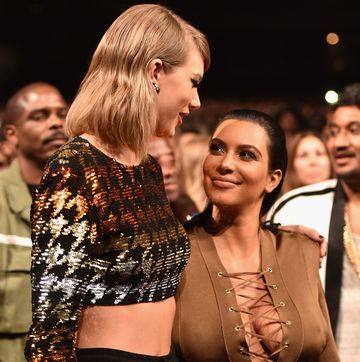Styling by Joanna Hir and makeup by Hadeel El-Tal.
Six years ago, at age 20, singer/artist/model Viktoria Modesta convinced doctors to remove her lower left leg. The limb was damaged at birth, and Modesta had already underwent 15 surgeries to fix it. "I had this confidence inside me, but it was clear that my physicality didn't really match my ambition," she told ELLE.com. "There was a lot of uncertainty hanging over my health, [and] I was determined to fix that so I could do all the things I dreamed of." So she ultimately had it removed, opting for a prosthetic. She describes the process as "going from economy to first class."
Today, Modesta's prosthetic—whether its form is encrusted with Swarvoski crystals, light-up, or a literal spike—is one of her biggest assets. The Latvian-born, UK-based pop star-in-the-making set the internet ablaze this week with the video for her new song 'Prototype,' which has been viewed, as of this writing, two and a half million times. The video brands Modesta as "bionic"— a "new kind of pop star." Its message, a kind of rebranding of disability ("Forget what you knew about disability," a message reads, at the start of the video), is deeply personal for Modesta. "I am a genuine character," she says, "and it feels like people have been waiting for that, to be able to relate to somebody who isn't trying to sell them some kind of unobtainable dream."
ELLE.com talked to Modesta about the video's concept, the origin behind that striking finale dance en pointe spike, and how she hopes she can truly change the industry's view of beauty.
So where did the idea for the video come from?
Well, I've been doing music and modeling with alternative prosthetics for a while now, it's been about six years. Channel 4, a revolutionary, progressive channel in the UK [that] really champion[s] alternative voices, got in touch with me and said we've been looking for someone that can represent the superhuman, bionic concept past the Paralympics, and we'd really like to give you a platform in the mainstream media. It was very much a no compromises project. We searched for the right director for seven months and then we eventually found Saam Farahmand. He interpreted what I've been trying to do for the last six years and who I wanted to be. He came up with this fantastic vision in terms of the set design and the script, and then my stylist Joanna Hir and myself, we very much pulled it together. It was a very collaborative project that stemmed from [Channel 4] discovering me in the depths of London culture.
How did you get your start in London?
[I came] over to London [from the former USSR] at the age of 12, just having an insatiable curiosity for music and fashion and having the need to explore it.
I went to performing art school when I was a child even though I didn't spend much time in there. [Modesta dropped out of high school.] I did get a musical start playing piano, but then when I was 14, I started having people approach me to be in videos or to model for their fashion brands and stuff. At the time, I had this confidence inside me, but it was clear that my physicality didn't really match my ambition. There was a lot of uncertainty hanging over my health, [and] I was determined to fix that so I could do all the things I dreamed of.
And to do that, after having been through 15 surgeries to fix your leg, you opted to remove it. What was that like?
For a lot of people, the loss of a limb is a traumatic experience. It's often described as losing a part of [yourself], but for me, it was like an upgrade. It was like going from economy to first class. I had so many health problems with that leg. I was not able to do sports and not able to wear heels—even walking was an issue. I just didn't feel balanced and strong. When I had my leg removed, I was able to actually make a choice about what kind of leg I could have, like how it's going to look and what it's going to do. It was incredible. I think that a lot of people don't realize how much choice they really have in life. People have recently been asking me if I really connect to having a disability and I say no. I say what I represent is that kind of free spirit. What I really try to concentrate on [is] staying true and choosing your own path. You don't have to be stuck in a script that somebody else has written for you.
And that's such an empowered stance. How did you adapt it?
[Growing up,] my mother's attitude toward me definitely helped me feel like there was nothing wrong with me, and I've always been a dreamer. More recently, I've met many people who just help me bloom. There are people out there who help you believe in your dreams and aspirations—help you believe that your ideas aren't just a load of rubbish and that you should pursue whatever your gut tells you to. That's when the magic happens. [Being a] positive individual who just loves life and who [is] excited about things and the world and people, that's what really counts—not that many people can knock that.
Definitely. Yet there's so much negativity and criticism out there. How do you deal with it?
It is important to eliminate negativity around yourself. If I listened to every negative thing that was said to me, I don't even know if I'd be alive by now, you know? It took a combination of self belief and support to stay optimistic. I didn't just end up here overnight, and I didn't wait for the world to come and get me out of bed. [Laughs] I've been working so so hard. I couldn't agree with the negative expectations I received a lot during childhood and adolescence. I simply felt that it was wrong. So I did whatever I thought was right for me and that made me happy and fulfilled. You can't beat that. It's all about just being the best version of yourself.
Your video starts by saying "Forget what you know about disability." What misconceptions did you want to change?
The message of the video is the campaign Born Risky that Channel 4 and I have worked on together. For them, it's about a bigger picture of disability. For me, it's a more personal mission of self discovery. Together, hopefully it can provoke people to feel things they haven't felt before. I have encountered attitudes toward people who might be considered disabled where people just don't expect them to be high achievers in the real world. That's a big problem in my mind. For the media industry to have someone in the role of a cultural leader would be a very dramatic change. The variety in the music and fashion world just needs to be broader, in my opinion. It would be fantastic if people of all ethnic backgrounds, physicality, and sexuality were able to exist in the media spotlight without getting a shock or a negative reaction. It's important to see they can be just as powerful and accomplished of an individual as anybody else is.
Do you feel like you're paving the way for more acceptance?
I don't know. I genuinely, genuinely don't know. I'm having some very fascinating conversations within the industry regarding modeling and music. I think it's how the industry is going to react to me that's really going to signify if the industry is able to embrace change. A lot of the time the messaging that [the public] gets [from the media] is that they don't have enough, and they should have more and that they're not right, they're not okay. [But] there is enough space to make room for some more meaningful content that's still about glossy fashion, beauty, and music. Have it be more real and just more encouraging to be a better person, not perfect.
Right, so when we look at a magazine, we don't feel like we need to be prettier.
Yeah, and I'm guilty of following the media and feeling like I need to fit in at times, [especially] in the past. And it's only because I have such an extreme difference on my body where I was thinking, "For crying out loud!" I'm looking at all the magazines and all the videos and was just like, "It doesn't matter how much I try, I'm never going to be fitting that ideal so what is the point? Why am I doing this? I should start actually enjoying being who I am as opposed to constantly trying to be someone that I'm not—someone else's ideal—and feeling miserable about it." I'm a really firm believer that it's about not focusing on what you don't have but working to your strengths.
Exactly. And you embody strength itself in the video with your prosthetics. Where did the idea for each come from?
The crystal leg in there was actually from the Paralympics closing ceremony and that was designed by myself and Sophie [de Oliveira Barata], who runs the Alternative Limb Project. Then there was the light leg, which was very much the director's idea. And the spike leg was my idea. I was trying to imagine what would make me feel completely badass and transform me, and it was the next step from wearing the highest stiletto you will ever wear! [Laughs] The scene setting in which I was dancing really brought the spike character alive.
Yeah, that dance in the end was incredible. What kind of prep went into it?
I didn't have any official dance training. It was very much a freestyle in that section unlike the other parts that I worked on with Jay Ravel. I tried to get into the harness a couple days before to see how it would feel and what I was going to be able to do. That section was very much like, "I'm wearing this spike. I'm in this space I'm in. Let's see what I can do, what feels natural." And what felt natural was making it dramatic, powerful, and sexual. Everyone I speak to interprets that section differently.
Overall, what's the one thing you want people to understand about you and this project?
That I'm not here just championing disability; I'm here to express freedom of choosing your own identity. Also, I represent years of my own evolution of style and idea[s]. It's not manufactured. Many people don't do their research and think I didn't write the song, that it was all somebody else's ideas and that I exploited myself for money. And that's just the sadness of the media industry. People are so used to being sold false made-up stories and characters. They don't have much trust [so] it's very hard for them to accept that it's possible I'm just a girl doing my thing, [and] I just got a break doing exactly what I love.
…Staying genuine is my biggest mantra. You can't go wrong with that because your dreams and goals make you truly fulfilled and happy. What can be better than that? [Laughs]
Learn more about Modesta on her site and watch the 'Prototype' video below.


